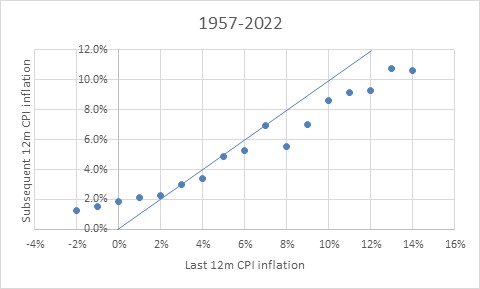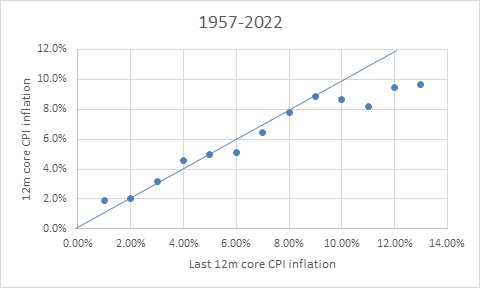Over the last couple of decades, the assumption that inflation is mean-reverting to something approximating the Fed’s target level (or to where inflation expectations are supposedly – without any evidence advanced to support the notion – ‘anchored’) has become a key component of most economists’ models.
I’ve discussed before how after a quarter-century of having low and stable inflation, any model which did not assume mean reversion has been discarded because it made bad predictions over that period compared to ones which did.
A critical follow-up question is whether a model should assume mean reversion in inflation. My observation implicitly says that it should not. If I’m wrong, and inflation in fact is mean-reverting, then the right models won and there’s no real problem.
So, did the right models win?
There are many sophisticated ways to test for mean reversion, but an intuitive one is this: for a given current level of inflation, which is a better guess:
- a) Inflation will be closer to the ‘mean’ in the next period;
- b) Inflation will be about the same distance from the mean (homeostasis), neither pulling towards the mean nor pushing away from the mean;
- c) inflation will be further away from the mean, such that deviations from the mean get amplified over time.
In the case of 'b' (homeostasis), we would say that inflation itself has momentum; in the case of 'c', we would say the acceleration of inflation has momentum. The latter case seems an unlikely case of extreme instability: it says that once prices move away from equilibrium, the economy either enters into an inflationary spiral or a deflationary spiral with no clear end. While this clearly can eventually happen in the hyperinflation case, those cases seem to have other causes that tend to amplify the swings (notably, an accelerating loss of faith in the currency itself).
Let’s consider the first and second scenarios, and look at some historical data.
The chart below shows the period 1957-2022. The x-axis indicates the current level of inflation, (I collapse the range from -0.5% to +0.5% and call it 0%, +0.5% to +1.5% and call it 1%, etc), and the y-axis shows the average inflation over the subsequent one year. So, the point that is at [2%, 2.3%] shows that between 1957 and 2022, if inflation was between 1.5% and 2.5% then the average inflation over the ensuing 12 months was 2.3%.

I’ve drawn a line that indicates inflation at the same level at the point of observation and subsequently (x=y). Notice that for any number below x=2%, y tends towards 2%. This shows that when the current reading is very low inflation or deflation, the subsequent year we tend to get something close to 2%.
Notice that at higher rates of inflation, the dots are below the line – meaning that if inflation is high, the following year tends to see inflation closer to the target.
So, this is what we would think mean reversion would look like (and FWIW, it is more pronounced if you choose a longer historical period but because the next chart I am showing is core CPI and we only have data to 1957, I wanted to use the same range).
Case closed! Inflation mean reverts!
Well, not exactly. This is headline inflation. We already know that food and energy tend to mean-revert; that is, after all, why economists exclude food and energy – because we know that high energy readings lead to high inflation prints, and we don’t want monetary policy to overreact to inflation that isn’t really persistent.
So, let’s look at core instead.

This chart looks different in key aspects. Except for very high core readings (with comparatively few observations that happen to coincide with when Volcker was aggressively tightening policy), the best estimate for core inflation over the next 12 months is not something closer to the assumed mean; the best estimate is the same level as what we have right now.
What that means – and it is super important – is that inflation has momentum. Keep in mind that during most of the period shown here, the Federal Reserve was actively trying to make inflation mean-revert. And they didn’t succeed, at least on a one-year basis.
Well, monetary policy works with long and variable lags, right? How about core inflation over the period 12-24 months from now? Surely then we should see some mean reversion?

The answer, at least for core inflation, is decidedly no…except for very high current readings of inflation.
Two takeaways:
- Inflation has momentum. This means that forecasting core inflation to return to the target level, just because we think it should, is a bad forecasting approach.
- Monetary policy seems to have had, at least over this period, very little effect. Generously, it didn’t have an effect on average…so perhaps sometimes the Fed overshot and other times it didn’t do enough. There is indeed a range. For example: starting from 5% y/y core inflation (between 4.5% and 5.5%), the 10th percentile of the 1y CPI outcomes after that was 3.5% and the 90th percentile was 6.0%. Starting from 7%, the 10th percentile was 3.1% and the 90th was 9.6%. So the average includes some times when inflation kept going up and some times when it was going back down.
The corollary to the second takeaway…call it takeaway 2a…is this: by the same token, there’s not a lot of reason for the Fed to be super aggressive raising rates to rein in inflation. We know that they can do harm. It’s less clear that they can do a whole lot of good!
. . .
Check out my Inflation Guy Podcast for more insights.
